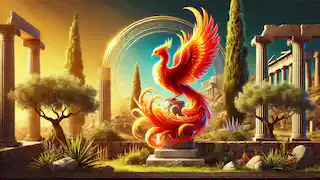Long ago, in the cradle of civilization where the Aegean tides sang to the stars and the whispers of oracles wove the fate of mortals and gods, a legend was born. Among the tales of heroes, titans, and monsters, the story of the Phoenix stood as a unique testament to life’s enduring spirit. The Phoenix, a bird of unmatched beauty and power, was said to be the bridge between life, death, and rebirth. This immortal creature, wrapped in the splendor of flames and renewal, traversed epochs, transcending the mortal coil and weaving its narrative into the fabric of human belief.
This story, told through the ages, reveals the Phoenix’s origins, its trials, its immortal purpose, and the profound lesson it imparts to all who hear its tale. Before the world was as we know it, when chaos reigned supreme and the primordial deities fought for control, the elements were locked in an eternal struggle. Fire, earth, air, and water clashed in a dance of creation and destruction. It was in this maelstrom that the first Phoenix was born. When fire met the pure essence of air, their union created a spark so bright that it tore through the darkness, giving rise to a magnificent creature. The Phoenix emerged from the flames fully formed, its wings shimmering with hues of red, orange, and gold. Each feather seemed to hold a fragment of the sun’s light, and its eyes burned with a wisdom older than time itself. As it stretched its wings for the first time, a song escaped its beak—a haunting melody that resonated across the heavens and the earth. This was no ordinary bird; it was a being imbued with the power of life and renewal, destined to wander the world as a symbol of hope and resilience. Gaia, the Earth Mother, beheld this new creation with wonder and gave it a purpose: “Phoenix, you are to roam the lands, bringing warmth to the cold, light to the darkness, and hope to despairing hearts. And when your time comes, you shall embrace death, only to rise anew from your ashes, brighter and stronger than before.” The Phoenix accepted its fate, for it knew that its existence was a gift to the world—a reminder of the cycles that govern all life. The Phoenix began its journey across the world, its brilliant plumage a beacon of light against the vast skies. It flew over the icy peaks of Mount Olympus, its warmth melting snowcaps and giving life to mountain springs. It soared across deserts, where its presence brought rain to parched lands. In dense forests, its song awakened slumbering seeds, bringing forth vibrant blooms. Mortals who witnessed the Phoenix were awestruck. They marveled at its radiant beauty and revered it as a divine messenger. Shrines were built in its honor, and its image was etched into pottery and carved into stone. Poets sang of its grace, and philosophers pondered its existence, calling it an embodiment of the eternal flame of life. Despite its revered status, the Phoenix remained humble, understanding that its power was not its own but a gift to be shared. Yet, its journey was not without challenges. It often found itself at odds with forces of darkness that sought to snuff out its light. The Phoenix’s brilliance did not go unnoticed by the gods. Nyx, the primordial goddess of the night, grew envious of the creature that dared to illuminate her domain. Darkness, after all, was her sacred realm, and she saw the Phoenix as an intruder. Her heart, once as vast as the night sky, became clouded with malice. Nyx sought counsel from Erebus, the god of darkness and her eternal consort. Together, they devised a plan to capture the Phoenix and extinguish its light forever. They wove a trap of shadows, an intricate web that would enclose the bird and drain its fiery essence. On a moonless night, as the Phoenix soared over the Aegean, its flames casting golden reflections on the water, Nyx unleashed her trap. Shadows rose from the depths, wrapping around the Phoenix like a cocoon. For the first time in its existence, the Phoenix felt fear as its light dimmed, its song silenced by the suffocating darkness. Yet, even in this dire moment, the Phoenix’s resolve remained unbroken. Summoning the last of its strength, it ignited its core, unleashing a fiery explosion that shattered the shadowy prison. The effort left the Phoenix gravely weakened, its feathers scorched and its body frail, but its spirit burned brighter than ever. The Phoenix, drained and vulnerable, found refuge in a secluded grove hidden within the valleys of Delphi. Here, surrounded by ancient olive trees and the whispers of the Pythia, the creature succumbed to its injuries. Its once-radiant feathers crumbled to ash, and its song faded into silence. Three days passed, and the grove lay shrouded in an eerie stillness. Then, from the pile of ashes, a spark ignited—a small flame that grew and spread, consuming the remnants. From this fire emerged the reborn Phoenix, its form more resplendent than before. Its wings seemed to hold the very essence of dawn, and its song carried a new depth, filled with both sorrow and triumph. This cycle of death and rebirth became the Phoenix’s defining characteristic. Mortals who witnessed its return marveled at the miracle, seeing in it a reflection of their own struggles and the hope of renewal. The Phoenix’s rebirth marked a turning point in its relationship with humanity. Mortals began to see the bird not just as a divine creature but as a symbol of resilience. Farmers prayed to the Phoenix for bountiful harvests, warriors sought its blessing before battle, and poets invoked its spirit to inspire their works. One tale tells of a young shepherd named Thales, who, struck by tragedy when his village was destroyed by raiders, sought solace in the wilderness. Wandering aimlessly, he stumbled upon the Phoenix, perched atop a charred oak tree. The bird’s presence filled Thales with a strange sense of peace. He watched as the Phoenix sang, its melody weaving tales of renewal and hope. Inspired, Thales returned to his village and led his people in rebuilding their homes, guided by the lessons of the Phoenix. Such stories spread far and wide, cementing the Phoenix’s place in the hearts of mortals. News of the Phoenix’s deeds reached the ears of the Olympian gods, who invited the creature to their celestial abode. Zeus, impressed by the Phoenix’s resilience, welcomed it as an honored guest. The bird’s presence brought warmth to the halls of Olympus, and its song uplifted even the most solemn of deities. Hera, however, viewed the Phoenix with suspicion. Ever wary of anything that might rival her grandeur, she decided to test the bird’s loyalty. She presented the Phoenix with a golden cage, adorned with jewels and promises of eternal comfort. But the Phoenix, wise beyond its years, saw the cage for what it was: a trap. With a defiant cry, it turned away, choosing freedom and purpose over gilded captivity. This act of defiance earned the Phoenix the respect of Zeus, who declared it a symbol of endurance and integrity. The gods decreed that the Phoenix would forever be a bridge between the mortal and divine realms, a reminder of the eternal cycles that govern existence. The Phoenix continued its wanderings, its flame illuminating forgotten corners of the world. It ventured to the distant lands of Hyperborea, where it brought light to the perpetual twilight, and to the volcanic forges of Hephaestus, where it rekindled dying flames. The bird became a guide to heroes, aiding them in their quests. It was said to have guided Theseus through the labyrinth, its fiery glow lighting the way to the Minotaur. It appeared to Odysseus, offering a moment of solace during his long journey home. Yet, the Phoenix’s life was not without sorrow. It bore witness to the wars of mortals, the betrayal of friends, and the fleeting nature of human life. Each time it died and was reborn, it carried the weight of these memories, its song echoing with the joys and sorrows of countless lives. As centuries passed, the Phoenix’s story transcended myth. Its image appeared on coins, its feathers were used as symbols of power in art, and its essence was woven into the philosophies of thinkers like Socrates and Plato. The Phoenix came to represent not just immortality but the resilience of the human spirit—the ability to rise from adversity and find meaning in renewal. Even today, the tale of the Phoenix inspires people across the world. It serves as a beacon for those who face challenges, a reminder that from the ashes of despair can arise the flames of hope. Some say the Phoenix still soars above the mountains and seas of Greece, its golden light a reminder of the eternal cycles of life. Its song, though faint, continues to inspire, carrying the promise that no matter how dark the night, the dawn will always come.Birth of the Phoenix

The Wanderer of the Skies
Nyx’s Envy
The First Death and Rebirth
The Phoenix and Humanity

The Phoenix and Olympus
The Eternal Journey

Legacy of the Phoenix

Epilogue

















